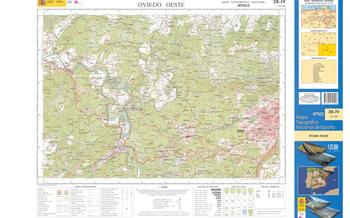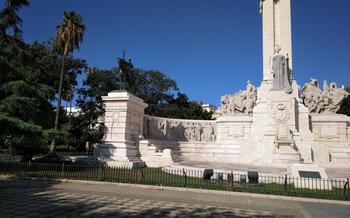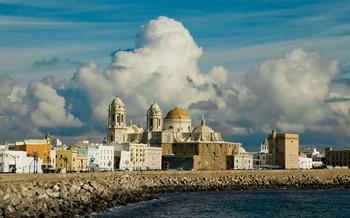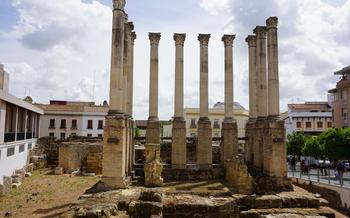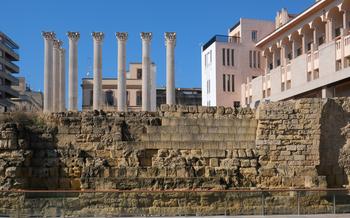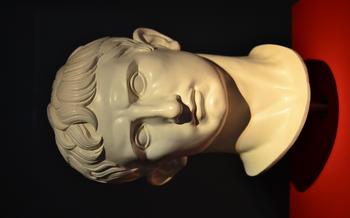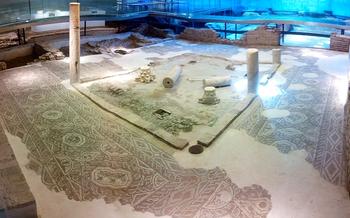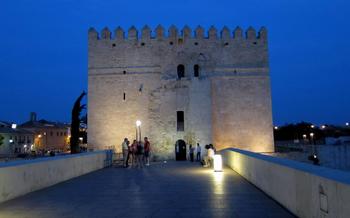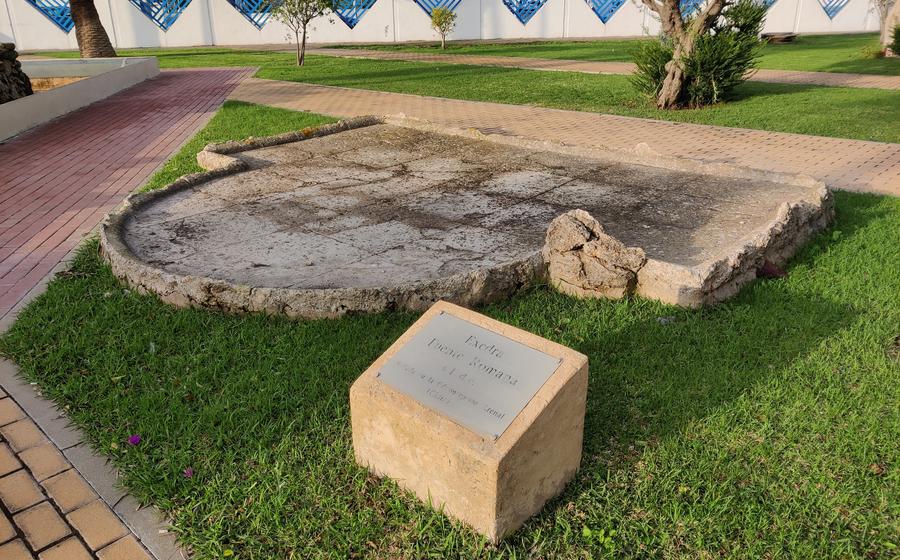
Cádiz Roman Archaeological Site
- A City with Ancient Ruins
- Excavating History
- A Walk Through Time
- The Mighty Theater
- Echoes of Performances
- A Place of Worship
- Market Square and Basilica
- A Thriving Neighborhood
- A Testimony to Resilience
- Museum of Cádiz
- Exploring the City
- The Festival of Bacchus: A Dionysian Celebration in Cádiz
- A Culinary Experience
- Insider Tip
A City with Ancient Ruins
Cádiz, a captivating city in southern Spain, boasts a rich history that dates back over three millennia. Its strategic location at the southwestern tip of the Iberian Peninsula has played a pivotal role in shaping its destiny. Founded by the Phoenicians in the 11th century BC, Cádiz served as a crucial trading hub, connecting Europe with the vast Mediterranean world.
Over the centuries, Cádiz witnessed the rise and fall of various civilizations, each leaving its indelible mark on the city's landscape. The Romans, who arrived in the 3rd century BC, transformed Cádiz into a thriving port city, constructing impressive monuments and infrastructure that showcased their architectural prowess.
Today, Cádiz is a vibrant blend of ancient and modern, where history unfolds at every turn. Its narrow cobbled streets, lined with charming whitewashed houses, lead to hidden squares and picturesque plazas, while the city's iconic landmarks stand as testaments to its enduring spirit. The Cádiz Roman Archaeological Site, a treasure trove of ancient ruins, offers a glimpse into the city's glorious past, inviting visitors on a journey through time.
Excavating History
The story of the Cádiz Roman Archaeological Site began in the 1980s when construction workers stumbled upon ancient ruins while laying the foundation for a new building. This discovery sparked an extensive excavation project that lasted for several years, revealing a wealth of well-preserved Roman structures that shed new light on the city's rich past.
The excavation process presented numerous challenges. The site was located in the heart of the modern city, surrounded by existing buildings and infrastructure. Archaeologists had to work carefully to avoid damaging these structures while simultaneously preserving the integrity of the ancient ruins. Moreover, the site was partially submerged in groundwater, which required the use of specialized techniques to pump out the water and create a stable working environment.
Despite these challenges, the excavation team made significant progress, uncovering a remarkable collection of buildings that included a theater, a temple, a market square, and a basilica. These structures provided valuable insights into the daily life, culture, and religious practices of the ancient Romans who inhabited Cádiz. The artifacts discovered at the site further enriched our understanding of the city's history, revealing information about its economy, trade, and artistic traditions.
A Walk Through Time
The Cádiz Roman Archaeological Site offers a captivating journey through the city's ancient past. As you wander through the excavated ruins, you'll encounter a variety of structures that provide glimpses into the lives and culture of the Roman inhabitants.
One of the most impressive features of the site is the well-preserved urban layout. The streets are still visible, along with the foundations of houses, shops, and other buildings. This layout provides a fascinating insight into the organization and planning of a Roman city.
Among the excavated structures, the theater stands out as a remarkable example of Roman architecture. With a capacity of over 20,000 spectators, it is one of the largest theaters in the Roman world. The stage, orchestra, and seating areas are all well-preserved, allowing visitors to imagine the grandeur of theatrical performances in ancient times.
Another significant structure is the temple, which was dedicated to the Roman gods Jupiter, Juno, and Minerva. The temple's imposing façade and intricate carvings offer a glimpse into the religious beliefs and practices of the Roman people.
The site also features a market square, which was the center of commercial activity in Roman Cádiz. Here, you can see the remains of shops, stalls, and a basilica, which served as a courthouse and administrative center.
Throughout the site, visitors can admire a variety of artifacts that have been unearthed during the excavations. These include sculptures, mosaics, pottery, and coins, which provide valuable insights into the daily lives and customs of the Roman inhabitants.
The Mighty Theater
The awe-inspiring theater of the Cádiz Roman Archaeological Site is a testament to the grandeur and cultural significance of Roman society. With a seating capacity of over 20,000 spectators, this magnificent structure stands as the largest theater ever discovered in the Roman world. Its impressive dimensions are matched by its intricate architectural features and design, showcasing the Romans' mastery of engineering and aesthetics.
The theater's cavea, or seating area, is divided into three tiers, each supported by a series of vaulted galleries. The lower tier, known as the ima cavea, was reserved for the city's elite, while the middle and upper tiers, the media and summa cavea, accommodated the general public. The stage, or scena, is adorned with elaborate marble columns and niches that once housed statues of Roman deities. Behind the stage, a grand backdrop, known as the scaenae frons, depicts mythological scenes in exquisite detail, adding to the theater's visual splendor.
Beyond its architectural magnificence, the theater held profound significance in Roman society. It served as a venue for theatrical performances, musical concerts, and other forms of entertainment, providing a much-needed respite from the rigors of daily life. These performances played a crucial role in shaping public opinion, promoting cultural values, and reinforcing the authority of the ruling elite.
Echoes of Performances
The theater's stage, measuring an impressive 12 meters in diameter, once played host to a variety of performances, transporting spectators to different worlds through the magic of storytelling. The seating arrangements, meticulously designed to ensure optimal acoustics and visibility, allowed the audience to fully immerse themselves in the unfolding dramas, comedies, and musical spectacles.
Actors, adorned in elaborate costumes and masks, brought myths, legends, and historical tales to life, captivating the hearts and minds of the audience. The theater's acoustics, carefully engineered to amplify and enhance the actors' voices, created an intimate and immersive atmosphere, drawing the spectators into the emotional depths of the performances.
The theater was not only a place of entertainment but also a platform for social commentary and cultural expression. Playwrights used their works to explore contemporary issues, satirize societal norms, and celebrate the triumphs and follies of human nature. The audience, drawn from all walks of life, engaged in lively discussions and debates, dissecting the themes and messages conveyed in the performances.
A Place of Worship
Amidst the bustling streets of ancient Gades, where commerce thrived and people from diverse cultures mingled, stood a sacred sanctuary—the temple. Its imposing structure, adorned with intricate carvings and vibrant frescos, beckoned worshippers seeking solace and divine guidance. Dedicated to the revered deities of the Roman pantheon, this temple served as the spiritual heart of the city, echoing with the prayers and rituals of a devoted community.
The temple's design exuded an aura of grandeur, with its towering columns reaching towards the heavens, supporting a majestic portico that sheltered the entrance. Inside, the spacious cella housed the sacred statues of the gods, their serene expressions casting an ethereal glow upon the devotees who came to pay their respects. The altar, adorned with intricate reliefs depicting mythological scenes, served as the focal point of religious ceremonies, where offerings were made and prayers ascended in clouds of fragrant incense.
The temple was not merely a place of worship but also a symbol of the deep religious beliefs that permeated every aspect of Roman life. Here, the citizens of Gades sought divine favor, celebrated religious festivals, and sought guidance in times of uncertainty. The temple stood as a testament to the enduring power of faith and the profound reverence with which the Romans regarded their gods.
Market Square and Basilica
The market square, known as the Macellum, was a bustling hub of commercial activity in Roman times. Surrounded by shops and stalls, it was the place where locals bought and sold fresh produce, fish, meat, and other goods. The square was also a social gathering place, where people could catch up on the latest news and gossip.
The basilica, located adjacent to the market square, was the administrative center of the city. It was here that officials conducted business, held meetings, and dispensed justice. The basilica was also used as a place of worship, with a temple dedicated to the Roman gods Jupiter, Juno, and Minerva.
Both the market square and the basilica were impressive structures, adorned with intricate mosaics, sculptures, and columns. Their discovery has provided valuable insights into the everyday life and governance of Roman Cádiz.
A Thriving Neighborhood
The Cádiz Roman Archaeological Site offers a glimpse into the daily life of the people who lived in this vibrant neighborhood during Roman times. The surrounding area was bustling with shops, workshops, and other commercial establishments, creating a sense of economic activity and community.
One can envision the hustle and bustle of the neighborhood, with merchants selling their wares, artisans crafting their goods, and people going about their daily business. The streets would have been filled with the sounds of hammers, the chatter of customers, and the laughter of children playing.
The presence of these commercial establishments suggests that the neighborhood was a thriving hub of trade and commerce. It was likely a place where people from all walks of life came together to buy and sell goods, exchange ideas, and socialize.
The discovery of these shops and workshops provides valuable insights into the economic and social structure of Roman Cádiz. It reveals the importance of this neighborhood as a center of commerce and industry, contributing to the city's prosperity and growth.
A Testimony to Resilience
The Cádiz Roman Archaeological Site stands as a testament to the resilience and enduring legacy of the ancient city. Despite the passage of time and the challenges posed by natural elements and urban development, the site has been meticulously preserved and maintained, allowing visitors to glimpse into the past and appreciate the grandeur of Roman architecture.
Ongoing restoration projects play a crucial role in safeguarding the site's integrity. Archaeologists, conservators, and historians collaborate to restore and protect the excavated structures, ensuring their preservation for future generations. These efforts involve meticulous cleaning, structural reinforcement, and the careful replacement of damaged elements using traditional techniques.
The preservation of the Cádiz Roman Archaeological Site is a testament to the city's commitment to its rich heritage. By protecting and maintaining this invaluable treasure, Cádiz ensures that visitors can continue to explore and learn from the remnants of a once-thriving Roman city, gaining a deeper appreciation for the enduring spirit of its ancient inhabitants.
Museum of Cádiz
The Museo de Cádiz is an archaeological and fine arts museum located in the city of Cádiz, Spain. It was founded in 1838 and is one of the oldest museums in Spain. The museum houses a collection of artifacts from the Cádiz Roman Archaeological Site, as well as other archaeological and artistic collections from the province of Cádiz.
The collection from the Cádiz Roman Archaeological Site includes a variety of artifacts, such as sculptures, mosaics, and pottery. The sculptures include representations of Roman gods and goddesses, as well as portrait busts of Roman emperors and other important figures. The mosaics depict scenes from Roman mythology and everyday life. The pottery includes both tableware and storage vessels.
The Museum of Cádiz is an important resource for understanding the history of Cádiz and the Roman Empire. The artifacts from the Cádiz Roman Archaeological Site provide a glimpse into the daily lives of the people who lived in the city during the Roman period. The museum also houses a collection of artifacts from other archaeological sites in the province of Cádiz, which provide a broader understanding of the region's history.
Exploring the City
Beyond the captivating ruins of the Roman Archaeological Site, Cádiz proudly boasts a treasure trove of attractions that beckon travelers from every corner of the globe. Take a leisurely stroll along the enchanting cobbled streets, where every turn reveals a new architectural marvel or a hidden gem. Gaze upon the awe-inspiring grandeur of the Cádiz Cathedral, its Gothic spires piercing the azure sky, silently narrating tales of history and devotion. Immerse yourself in the vibrant energy of the Mercado Central, where the air buzzes with the lively chatter of vendors and the tantalizing aromas of fresh produce and local delicacies. Discover the fascinating exhibitions at the Museo de Cádiz, where the past and present intertwine, showcasing the city's rich cultural heritage through captivating artifacts and interactive displays.
Indulge in the exquisite flavors of Cádiz cuisine at one of the many charming restaurants that line the picturesque streets. Savor the freshest seafood, expertly prepared with a unique blend of traditional and contemporary techniques, while enjoying the vibrant atmosphere and warm hospitality that define this enchanting city.
The Festival of Bacchus: A Dionysian Celebration in Cádiz
Amidst the ancient ruins of Cádiz, the spirit of Bacchus, the Roman god of wine and revelry, comes alive every year during the Festival of Bacchus. This vibrant celebration, held annually in the city, pays homage to the rich viticulture and viniculture traditions of the region.
The festival's roots can be traced back to Roman times when Cádiz was a thriving port city and a major center of wine production. The Romans celebrated Bacchus, also known as Dionysus in Greek mythology, with lavish festivals that honored his divine powers and celebrated the joys of wine.
Today, the Festival of Bacchus in Cádiz carries on this ancient legacy, combining historical reenactments, wine tastings, and lively street performances to create an unforgettable experience. During the festival, the streets of Cádiz are adorned with colorful decorations, and the air is filled with the aroma of wine and music.
Participants dressed in Roman attire parade through the city, reenacting ancient rituals and paying tribute to Bacchus. Wine enthusiasts can indulge in tastings of local wines from the Cádiz region, savoring the flavors and aromas of this historic beverage.
The festival also features traditional music and dance performances, transporting visitors back to the days of ancient Rome. Street artists, jugglers, and acrobats entertain the crowds, creating a lively and festive atmosphere.
The Festival of Bacchus is a unique opportunity to immerse oneself in the history and culture of Cádiz while celebrating the city's love for wine. Whether you're a wine enthusiast, a history buff, or simply looking for a fun and festive experience, this festival is a must-attend event.
A Culinary Experience
Cádiz is renowned for its delectable cuisine, a harmonious blend of fresh seafood, tantalizing spices, and unique cooking techniques. Whether you're a foodie or simply someone who appreciates a good meal, Cádiz offers an array of culinary delights that will leave your taste buds dancing.
Indulge in the freshest catches of the day, as Cádiz is blessed with an abundance of seafood. From succulent prawns and lobsters to tender squid and octopus, the variety of seafood dishes is simply astounding. Don't miss the opportunity to savor a plate of "pescaíto frito," a local specialty featuring fried fish, or try the "tortillitas de camarones," a crispy shrimp fritter that's a must-try.
Cádiz's cuisine is also heavily influenced by its rich history and cultural diversity. The "mojama," a cured tuna delicacy, and the "almadraba," a traditional tuna fishing technique, are testaments to the city's maritime heritage. Arabic influences can be found in dishes like "cuscús," a hearty semolina dish, and "albóndigas de choco," cuttlefish meatballs.
For a truly authentic experience, venture into the narrow streets of Cádiz and seek out the hidden gems that serve traditional dishes. From cozy tapas bars to family-run restaurants, there's no shortage of culinary treasures to discover. Don't forget to pair your meal with a glass of local wine, such as the renowned Sherry, for a perfect culinary journey.
Insider Tip
As you explore the Cádiz Roman Archaeological Site, keep an eye out for secret spots and hidden gems that offer unique perspectives and experiences. One such spot is the underground cistern, located beneath the theater. Accessible through a narrow passageway, this atmospheric chamber once stored water for the city's inhabitants. Its vaulted ceilings and cool, damp air create a sense of mystery and wonder.
For stunning photos, head to the upper levels of the theater. From here, you can capture panoramic views of the site, with the city of Cádiz and the sparkling waters of the bay as your backdrop. The golden light of sunrise or sunset casts a magical glow on the ancient ruins, creating unforgettable photo opportunities.
To avoid the crowds and experience the site in relative tranquility, plan your visit for off-peak hours. Early mornings or late afternoons are ideal times to explore at your own pace, soak up the atmosphere, and truly appreciate the grandeur of this ancient city.
